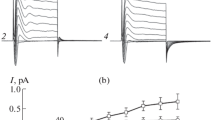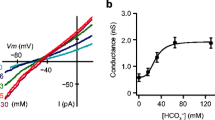Abstract
Single-channel current recordings were carried out on excised inside-out patches of baso-lateral plasma membrane from exocrine acinar cells. The mouse pancreas and submandibular gland as well as the pig pancreas were investigated.
In the mouse pancreas the voltage-insensitive Ca2+-activated cation channel was studied. Single-channel current-voltage (i/v) relationships were studied in symmetrical Rb+-rich solutions and in asymmetrical Rb+/Na+ and Na+/Rb+ solutions. In all cases the i/v relations were linear and had the same slope representing a single-channel conductance of about 33 pS which is identical to that previously obtained with symmetrical Na+ solutions or asymmetrical Na+/K+ solutions.
In the mouse submandibular gland and the pig pancreas the voltage and Ca2+-activated K+ channel was studied. The outward currents observed after depolarization in the presence of quasi-physiological Na+/K+ gradients were immediately abolished when all the K+ in the bath fluid was replaced by Rb+ (bath fluid in contact with inside of plasma membrane). This effect was immediately and fully reversible upon return to the high K+ solution.
The voltage and Ca2+-activated K+ channel was also studied in asymmetrical K+/Rb+ and Rb+/K+ solutions. In the first case inward (K+) currents could be observed but not outward (Rb+) currents, while in the other case inward (Rb+) currents could not be seen whereas outward (K+) currents were measured. The current-voltage relationships were approximately linear and the null potential was close to 0 mV in both situations. In contrast the null potential for current through the K+ channel in the presence of asymmetrical Na+/K+ or Li+/K+ solutions was about −70 mV and with reversed gradients about +60 mV.
Outward K+ currents of reduced size (through the voltage and Ca2+-activated K+ channel) could be observed when the bath fluid contained 75 mM K+ and 75 mM Rb+, but not (in the same membrane patches) when 150 mM Rb+ and no K+ was present.
It is concluded that the large voltage- and Ca2+-activated K+ channel has an extremely low Rb+ conductance. It is possible, however, that the permeability for Rb+ may be about the same as for K+. The voltage-insensitive Ca2+-activated cation channel does not discriminate between K+ and Rb+.
Similar content being viewed by others
References
Barry PH, Gage PW (1984) Ionic selectivity of channels at the end-plate. In: Stein WD (ed) Current topics in membranes and transport, vol 21, Ion channels Molecular and physiological aspects. Academic Press, New York, pp 1–51
Colquhoun D, Neher E, Reuter H, Stevens CF (1981) Inward current channels activated by intracellular Ca in cultured cardiac cells. Nature 294:752–754
Danielsson A, Sehlin J (1983) Effects of selective A1 and A2 adrenoceptor active drugs on86Rb+ efflux from pieces of rat parotid gland. Acta Scand Physiol 117:561–566
Gallacher DV (1982) Are there purinergic receptors on parotid acinar cells? Nature 296:83–86
Gallacher DV (1983) Substance P is a functional neurotransmitter in the rat parotid gland. J Physiol 342:483–498
Hamill OP (1983) Potassium and chloride channels in red blood cells. In: Sakmann B, Neher E (eds) Single-channel recording. Plenum Press, New York, pp 451–471
Hamill OP, Marty A, Neher E, Sakmann B, Sigworth FJ (1981) Improved patch-clamp techniques for high-resolution current recording from cells and cell-free membrane patches. Pflügers Arch 391:85–100
Henquin JC (1979) Opposite effects of intracellular Ca2+ and glucose on K+ permeability of pancreatic islet cells. Nature 280:66–68
Henquin JC, Meissner HP (1981) Effects of amino acids on membrane potential and86Rb+ fluxes in pancreatic B cells. Am J Physiol 240:E245-E252
Latorre R, Miller C (1983) Conduction and selectivity in potassium channels. J Membr. Biol 71:11–30
Läuger P (1973) Ion transport through pores: a rate theory analysis. Biochim Biophys Acta 311:423–441
Marty A (1981) Ca-dependent K channels with large unitary conductance in chromaffin cell membrane. Nature 291:497–500
Maruyama Y, Petersen OH (1982a) Single-channel currents in isolated patches of plasma membrane from basal surface of pancreatic acini. Nature 299:159–161
Maruyama Y, Petersen OH (1982b) Cholecystokinin activation of single-channel currents is mediated by internal messenger in pancreatic acinar cells. Nature 300:61–63
Maruyama Y, Gallacher DV, Petersen OH (1983a) Voltage and Ca2+-activated K+ channel in baso-lateral acinar cell membranes of mammalian salivary glands. Nature 302:827–829
Maruyama Y, Petersen OH, Flanagan P, Pearson GT (1983b) Quantification of Ca2+-activated K+ channels under hormonal control in pig pancreas acinar cells. Nature 305:228–232
Neher E (1982) Unit conductance studies in biological membranes. In: Baker PF (ed) Techniques in cellular physiology, part II. Elsevier/North-Holland, pp 121/1–16
Parod RJ, Putney JW (1978) An alpha-adrenergic receptor mechanism controlling potassium permeability in the rat lacrimal gland acinar cell. J Physiol 281:359–369
Petersen OH, Maruyama Y (1983) Cholecystokinin and acetylcholine activation of single-channel currents via second messenger in pancreatic acinar cells. In: Sakmann B, Neher E (eds) Single-channel recording. Plenum Press, New York, pp 425–435
Petersen OH, Maruyama Y (1984) Calcium-activated potassium channels and their role in secretion. Nature 307:693–696
Putney JW (1976) Biphasic modulation of potassium release in rat parotid gland by carbachol and phenylephrine. J Pharm Exp Ther 198:375–384
Putney JW (1979) Stimulus-permeability coupling: role of calcium in the receptor regulation of membrane permeability. Pharmacol Rev 30:209–245
Sehlin J, Taljedal I-B (1975) Glucose-induced decrease in Rb+ permeability in pancreatic B cells. Nature 253:635–636
Ussing HH (1960) The alkali metal ions in isolated systems and tissues. In: Ussing HH (ed) The alkali metal ions in biology, Handbuch der Experimentellen Pharmakologie, Ergänzungswerk, vol 13. Springer, Berlin Göttingen Heidelberg, pp 1–195
Weiss JJ, Putney JW (1978) Does calcium mediate the increase in potassium permeability due to phenylephrine or angiotensin II in the liver? J Pharmacol Exp Ther 207:669–676
Yellen G (1982) Single Ca2+-activated nonselective cation channels in neuroblastoma. Nature 296:357–359
Author information
Authors and Affiliations
Rights and permissions
About this article
Cite this article
Gallacher, D.V., Maruyama, Y. & Petersen, O.H. Patch-clamp study of rubidium and potassium conductances in single cation channels from mammalian exocrine acini. Pflugers Arch. 401, 361–367 (1984). https://doi.org/10.1007/BF00584336
Received:
Accepted:
Issue Date:
DOI: https://doi.org/10.1007/BF00584336




